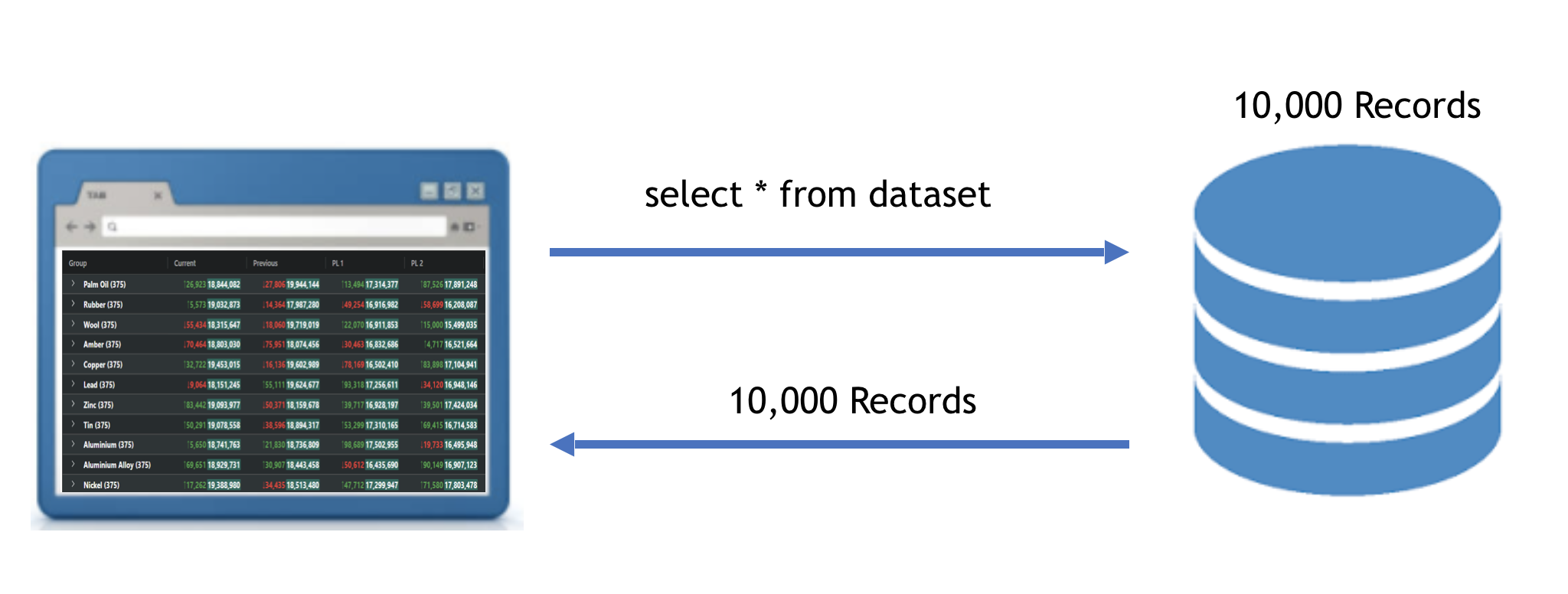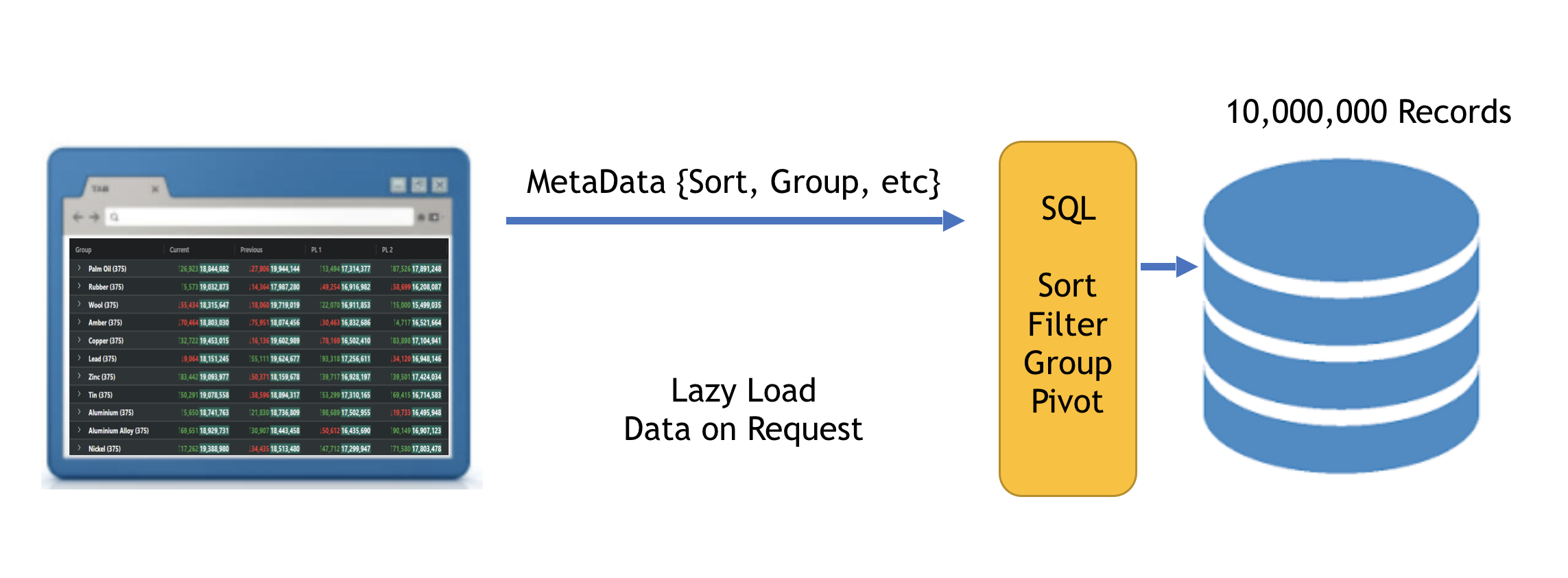Learn how to perform server-side operations using the Oracle Database with a complete reference implementation.
In this guide we will show how large datasets, which are too big be loaded directly into the browser, can be managed by performing server-side operations inside the Oracle database.
We will develop a financial reporting application that demonstrates how data can be lazy-loaded as required, even when performing group, filter, sort and pivot operations.
The reference implementation covered in this guide is for demonstration purposes only. If you use this in production it comes with no warranty or support.
The source code can be found here: https://github.com/ag-grid/ag-grid-server-side-oracle-example
Overview Copy Link
When designing a grid based application, one of the key considerations is how much data needs to be sent from the server to the client. As a developer using AG Grid you won't need to switch between grids based on the answer to this question, instead just select the appropriate Row Model used by the grid.
Client-Side Row Model Copy Link
The simplest approach is to send all row data to the browser in response to a single request at initialisation. For this use case the Client-Side Row Model has been designed.
This scenario is illustrated below where 10,000 records are loaded directly into the browser:

The Client-Side Row Model only renders the rows currently visible, so the upper limit of rows is governed by the browser's memory footprint and data transfer time, rather than any restrictions inside the grid.
Server-Side Row Model Copy Link
However many real world applications contain much larger datasets, often involving millions of records. In this case it simply isn't feasible to load all the data into the browser in one go. Instead data will need to be lazy-loaded as required and then purged to limit the memory footprint in the browser.
This is precisely the problem the Server-Side Row Model addresses, along with delegating server-side operations such as filtering, sorting, grouping and pivoting.
The following diagram shows the approach used by the Server-Side Row Model. Here there are 10 million records, however the number of records is only constrained by the limits of the server:

As the user performs operations such as sorting and grouping, the grid issues requests to the server that contains all the necessary metadata required, including which portion of data should be returned based on the user's position in the dataset.
The browser will never run out of heap space as the grid will automatically purge out-of-range records.
Throughout the rest of this guide we will demonstrate the power of the Server-Side Row Model with the aid of a Java service connected to an Oracle database.
Prerequisites Copy Link
It is assumed the reader is already familiar with Java, Maven, Spring Boot and Oracle.
This example was tested using the following versions:
- ag-grid-enterprise (v18.0.0)
- Java(TM) SE Runtime Environment (build 1.8.0_162-b12)
- Java HotSpot(TM) 64-Bit Server VM (build 25.162-b12, mixed mode)
- Apache Maven (3.5.2)
- Oracle 12c Release 2 (12.2.0.1)
- Oracle JDBC Driver (ojdbc7-12.1.0.2)
Due to Oracle licence restrictions the Oracle JDBC driver is not available in the public Maven repository and should be manually installed into your local Maven repository like so:
mvn install:install-file -Dfile={Path/to/ojdbc7.jar} -DgroupId=com.oracle -DartifactId=ojdbc7 -Dversion=12.1.0.2 -Dpackaging=jar
Also ensure the Oracle JDBC driver version also matches the Oracle POM dependency:
// pom.xml
<dependency>
<groupId>com.oracle</groupId>
<artifactId>ojdbc7</artifactId>
<version>12.1.0.2</version>
</dependency>
Download and Install Copy Link
Clone the example project using:
git clone https://github.com/ag-grid/ag-grid-server-side-oracle-example.git
Navigate into the project directory:
cd ag-grid-server-side-oracle-example
Install project dependencies and build project using:
mvn clean install
To confirm all went well you should see the following maven output:

Configure Oracle Copy Link
Update the Oracle configuration accordingly with your database connection details:
// src/main/resources/application.properties
spring.datasource.url=jdbc:oracle:thin:@//localhost:1521/orcl
spring.datasource.username=system
spring.datasource.password=oracle
Setup Data Copy Link
Run the following script in Oracle to create the table required in this example:
/* src/main/resources/schema.sql */
CREATE TABLE trade
(
product VARCHAR(255),
portfolio VARCHAR(255),
book VARCHAR(255),
tradeId NUMBER,
submitterId NUMBER,
submitterDealId NUMBER,
dealType VARCHAR(255),
bidType VARCHAR(255),
currentValue NUMBER,
previousValue NUMBER,
pl1 NUMBER,
pl2 NUMBER,
gainDx NUMBER,
sxPx NUMBER,
x99Out NUMBER,
batch NUMBER
);
Next run the following utility to populate it with data:
src/test/java/com/ag/grid/enterprise/oracle/demo/TradeDataLoader.java
Run the App Copy Link
From the project root run:
mvn spring-boot:run
If successful you should see something like this:

To test the application point your browser to http://localhost:9090
Server-Side Row Model Interfaces Copy Link
Our Java service will use the following request and response objects:
// src/main/java/com/ag/grid/enterprise/oracle/demo/request/ServerSideGetRowsRequest.java
public class ServerSideGetRowsRequest implements Serializable {
private int startRow, endRow;
// row group columns
private List<ColumnVO> rowGroupCols;
// value columns
private List<ColumnVO> valueCols;
// pivot columns
private List<ColumnVO> pivotCols;
// true if pivot mode is on, otherwise false
private boolean pivotMode;
// what groups the user is viewing
private List<String> groupKeys;
// if filtering, what the filter model is
private Map<String, ColumnFilter> filterModel;
// if sorting, what the sort model is
private List<SortModel> sortModel;
...
}
// src/main/java/com/ag/grid/enterprise/oracle/demo/response/ServerSideGetRowsResponse.java
public class ServerSideGetRowsResponse {
private List<Map<String, Object>> data;
private int lastRow;
private List<String> pivotResultColumnsFields;
...
}
We will discuss these in detail throughout this guide, however for more details see: Server-Side Datasource
Service Controller Copy Link
Our service shall contain a single endpoint /getRows with the request and response objects defined above:
// src/main/java/com/ag/grid/enterprise/oracle/demo/controller/TradeController.java
@RestController
public class TradeController {
private TradeDao tradeDao;
@Autowired
public TradeController(@Qualifier("tradeDao") TradeDao tradeDao) {
this.tradeDao = tradeDao;
}
@RequestMapping(method = POST, value = "/getRows")
@ResponseBody
public ServerSideGetRowsResponse getRows(@RequestBody ServerSideGetRowsRequest request) {
return tradeDao.getData(request);
}
}
The TradeController makes use of the Spring Controller to handle HTTP and JSON Serialisation.
Data Access Copy Link
The OracleSqlQueryBuilder dynamically generates SQL based on the supplied request. We will query the Trade table with our generated SQL using the Spring JDBC Template.
Here is the implementation of our TradeDao:
// src/main/java/com/ag/grid/enterprise/oracle/demo/dao/TradeDao.java
@Repository("tradeDao")
public class TradeDao {
private JdbcTemplate template;
private OracleSqlQueryBuilder queryBuilder;
@Autowired
public TradeDao(JdbcTemplate template) {
this.template = template;
queryBuilder = new OracleSqlQueryBuilder();
}
public ServerSideGetRowsResponse getData(ServerSideGetRowsRequest request) {
String tableName = "trade"; // could be supplied in request as a lookup key?
// first obtain the pivot values from the DB for the requested pivot columns
Map<String, List<String>> pivotValues = getPivotValues(request.getPivotCols());
// generate SQL
String sql = queryBuilder.createSql(request, tableName, pivotValues);
// query DB for rows
List<Map<String, Object>> rows = template.queryForList(sql);
// create response with our results
return createResponse(request, rows, pivotValues);
}
private Map<String, List<String>> getPivotValues(List<ColumnVO> pivotCols) {
return pivotCols.stream()
.map(ColumnVO::getField)
.collect(toMap(
pivotCol -> pivotCol, this::getPivotValues, (a, b) -> a, LinkedHashMap::new));
}
private List<String> getPivotValues(String pivotColumn) {
String sql = "SELECT DISTINCT %s FROM trade";
return template.queryForList(format(sql, pivotColumn), String.class);
}
}
Filtering Copy Link
Our example will make use of the grid's NumberFilter and SetFilter Column Filters. The corresponding server-side classes are as follows:
// src/main/java/com/ag/grid/enterprise/oracle/demo/filter/NumberColumnFilter.java
public class NumberColumnFilter extends ColumnFilter {
private String type;
private Integer filter;
private Integer filterTo;
...
}
// src/main/java/com/ag/grid/enterprise/oracle/demo/filter/SetColumnFilter.java
public class SetColumnFilter extends ColumnFilter {
private List<String> values;
...
}
These filters are supplied per column in the ServerSideGetRowsRequest via the following property:
Map<String, ColumnFilter> filterModel;
As these filters differ in structure it is necessary to perform some specialised deserialisation using the Type Annotations provided by the Jackson Annotations project.
When the filterModel property is deserialised, we will need to select the appropriate concrete ColumnFilter as shown below:
// src/main/java/com/ag/grid/enterprise/oracle/demo/filter/ColumnFilter.java
@JsonTypeInfo(
use = JsonTypeInfo.Id.NAME,
include = JsonTypeInfo.As.PROPERTY,
property = "filterType")
@JsonSubTypes({
@JsonSubTypes.Type(value = NumberColumnFilter.class, name = "number"),
@JsonSubTypes.Type(value = SetColumnFilter.class, name = "set") })
public abstract class ColumnFilter {
String filterType;
}
Here we are using the filterType property to determine which concrete filter class needs to be associated with the ColumnFilter entries in the filterModel map.
Sorting Copy Link
The ServerSideGetRowsRequest contains the following attribute to determine which columns to sort by:
private List<SortModel> sortModel;
The SortModel contains the colId (i.e. 'book') and the sort type (i.e. 'asc')
// src/main/java/com/ag/grid/enterprise/oracle/demo/request/SortModel.java
public class SortModel implements Serializable {
private String colId;
private String sort;
...
}
The OracleSqlQueryBuilder then appends accordingly to the ORDER BY clause:
// src/main/java/com/ag/grid/enterprise/oracle/demo/builder/OracleSqlQueryBuilder.java
orderByCols.isEmpty() ? "" : " ORDER BY " + join(",", orderByCols);
Grouping Copy Link
Grouping is easily achieved in the OracleSqlQueryBuilder by appending rowGroups to the GROUP BY like so:
// src/main/java/com/ag/grid/enterprise/oracle/demo/builder/OracleSqlQueryBuilder.java
private String groupBySql() {
return isGrouping ? " GROUP BY " + join(", ", rowGroupsToInclude) : "";
}
private List<String> getRowGroupsToInclude() {
return rowGroups.stream()
.limit(groupKeys.size() + 1)
.collect(toList());
}
Pivoting Copy Link
In order to perform pivoting we will use the OracleSqlQueryBuilder to generate a series of decode statements for each combination of pivot and value columns, such as:
sum (
DECODE(DEALTYPE, 'Financial', DECODE(BIDTYPE, 'Buy', CURRENTVALUE))
) "Financial_Buy_CURRENTVALUE"
These new pivot result columns are created using the row values contained in the data and have field names such as: Financial_Buy_CURRENTVALUE.
These will need to be returned to the grid in the ServerSideGetRowsResponse in the following property:
List<String> pivotResultColumnsFields;
Our client code will then use these secondary column fields to generate the corresponding ColDefs like so:
// src/main/resources/static/main.js
let createPivotResultColumns = function (fields, valueCols) {
let pivotResultCols = [];
function addColDef(colId, parts, res) {
if (parts.length === 0) return [];
let first = parts.shift();
let existing = res.find(r => r.groupId === first);
if (existing) {
existing['children'] = addColDef(colId, parts, existing.children);
} else {
let colDef = {};
let isGroup = parts.length > 0;
if (isGroup) {
colDef['groupId'] = first;
colDef['headerName'] = first;
} else {
let valueCol = valueCols.find(r => r.field === first);
colDef['colId'] = colId;
colDef['headerName'] = valueCol.displayName;
colDef['field'] = colId;
colDef['type'] = 'measure';
}
let children = addColDef(colId, parts, []);
children.length > 0 ? colDef['children'] = children : null;
res.push(colDef);
}
return res;
}
fields.sort();
fields.forEach(field => addColDef(field, field.split('_'), pivotResultCols));
return pivotResultCols;
};
In order for the grid to show these newly created columns an explicit API call is required:
api.setPivotResultColumns(pivotResultColDefs);
Infinite Scrolling Copy Link
The ServerSideGetRowsRequest contains the following attribute to determine the range to return:
private int startRow, endRow;
The OracleSqlQueryBuilder uses this information when limiting the results as follows:
// src/main/java/com/ag/grid/enterprise/oracle/demo/builder/OracleSqlQueryBuilder.java
private String limitSql() {
return " OFFSET " + startRow + " ROWS FETCH NEXT " + (endRow - startRow + 1) + " ROWS ONLY";
}
Conclusion Copy Link
In this guide we presented a reference implementation for integrating the Server-Side Row Model with a Java service connected to an Oracle database. This included all necessary configuration and install instructions.
A high level overview was given to illustrate the problem this approach solves before providing details of how to achieve the following server-side operations:
- Filtering
- Sorting
- Grouping
- Pivoting
- Infinite Scrolling